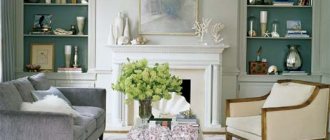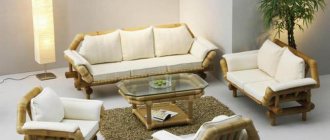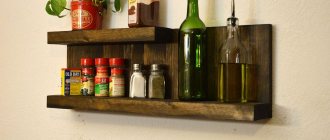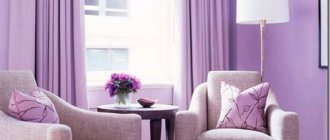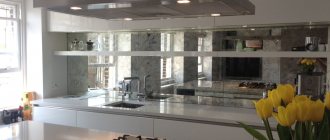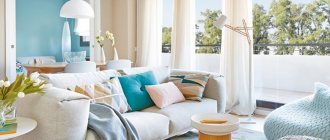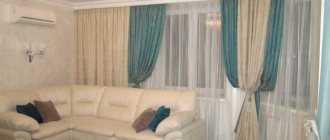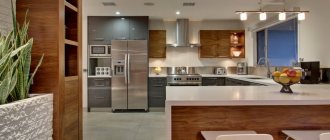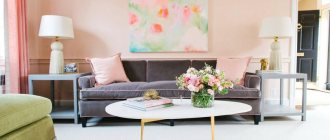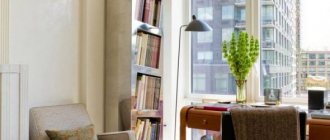What is retro style?
Retro style in the interior is brightness, cheerful mood and originality. The most important design ideas of the mid-twentieth century were reflected in the interior, decorated in retro style.
In many industries, including music, fashion and design, the word "retro" is used to describe the imitation of old trends and styles. In the world of interior design, "retro" usually refers to furniture typical of the decades between the 1950s and 1980s.
Pieces may be vintage and originally produced during that era, or simply take inspiration from the shapes and colors that characterized the style of that era. The final hallmark of retro style is the eclectic mix of old and new: design classics are interspersed with new pieces, combined to create a unique, cohesive look.
Retro is brightness, cheerful mood and originality
By today's design standards, "retro" is a style that confidently combines an authentic look with the best of modern technology, while remaining worthy of nostalgia.
Manufacturing method
Soft woods such as pine are best suited for artificial aging. You can, of course, work with hard ones, but such processing will require much more effort.
Furniture made from pine or other solid wood is an excellent alternative to boring molded products.
In any case, regardless of the interior item being created, be it a chair, table or cabinet, we first draw up a drawing, according to which we prepare the individual parts and their further assembly. Having collected any piece of furniture, we prepare it for further processing. Next, we will consider the most popular techniques.
Individual furniture made of pine, oak, beech and other types of wood is quite popular among residents of our country.
Artificial pollution
The effect of artificial pollution of all existing ones has the strongest visual effect. We wipe the wood with wax, and the darker its shade, the stronger the effect. Wax fills depressions in the surface of the wood, thereby enhancing the desired effect.
The furniture takes on the appearance of time-eaten wood.
Note! To obtain aged furniture, we recommend waxing in one direction over the entire surface area.
Patina
The patina effect (visual aging of the surface when the veins remain in their original form) is suitable for wood with the appropriate texture.
Aged furniture will delight its owners for a long time.
In furniture stores you can even find special paints that create a similar effect. Before starting work, the top layer of the selected furniture is thoroughly varnished. After the varnish has dried (usually within 24 hours), a special paint with a patina effect is applied.
Use professional furniture products.
The dried layer of paint is processed with sufficient force with medium-hard sandpaper. And thus the desired result is achieved.
Crackle
The crackle effect is artificial cracking of the surface. Produced by chemical compounds. We apply a special craquelure varnish to the surface and wait for the effect to appear.
Note! Before starting such work, the surface must be well cleaned.
The photo shows an example of furniture after aging using the crackle method.
Then we apply a pre-selected color on top of the varnish, which will visually enhance the effect. And at the end of the entire procedure, we cover the resulting surface with a layer of protective varnish to preserve the resulting aging for a long time.
Wooden furniture is an environmentally friendly product that has a long service life.
Coloring
In this case, the wooden surface is painted in several layers of color, often from the lightest to the darkest; the further to the final layer, the less effort is applied and the less surface is painted.
Furniture cleaning is carried out in a special room and wearing a mask.
Between adjacent layers, additional sanding is usually carried out, which enhances the effect.
Wood painting should also be carried out in specialized conditions.
As you can see, antique wooden furniture created with your own hands according to the above recommendations is a fascinating activity with the expected result of aging the selected interior items.
Why designs from the 50s, 60s and 70s are so interesting
The main reason is probably that it was the post-war period, which was characterized by euphoria, fresh ideas, the emergence of young designers and new artistic movements. Of course, all these innovations did not even make it through the interior design.
During these years, new materials, shapes and colors, as well as distinctive patterns, were used.
Typical retro style of the 50s and 60s
In this design direction, the distinctive features of the interior are:
- rounded shapes of devices with chrome elements;
- lamps of various shapes;
- curtains and blinds instead of curtains;
- glossy leatherette on square furniture;
- combination of wood and chrome on furniture;
- bold colors and geometric patterns on fabrics;
- posters printed instead of classic paintings and much more.
Typical retro style of the 70s
The 70s trend is characterized by designs that combine symmetry, compactness and slim shapes:
- small plastic furniture;
- hanging chairs;
- various side tables;
- furniture made of white and colored laminate;
- open shelves;
- modular sofas, corner sofas and much more.
Pre-war retro: from twenties to forties
Let's take a closer look at the different decades - they differ from each other in many ways. The period between the two world wars was marked by sharp contrasts.
The 20s are presented in all their glory in the film “The Great Gatsby”. Its interiors are life-affirming and luxurious. Notable details in the setting of that time:
- carved furniture made of dark wood;
- chic multi-tiered chandeliers;
- busts;
- paintings in gilded frames.
But there were also those who lived much more modestly. In the Soviet Union, too, not everyone was equal. Some began to live in communal apartments, where there was no time for excess decoration, while others could afford to live in multi-room apartments. One of these is illustrated in the film “Heart of a Dog”. There are many memorable elements in this interior:
- patterned floors;
- white doors with glass;
- large desk in the office;
- starched tablecloths;
- luxurious lampshades.
Kitchens of those times were characterized by the absence of furniture sets - all items stood separately, there were no wall cabinets, except for small open shelves.
Bureaus and secretaries were very popular in the 20s
Modern fantasies on the theme of the 30s
Typical things from the 40s - a round table with a colorful tablecloth, metal beds with armored mesh, a massive but low cabinet with rounded corners made of reddish wood, a beautiful buffet with dishes. Such furniture can also be found in modern interiors, stylized as retro.
FACT. Back in Tsarist Russia, there was a tradition of hanging mirrors high and at an angle. So you could see yourself in full growth. Paintings were hung in a similar way. The tradition turned out to be very persistent, and even now you can find such a reception in villages.
Forties style: you've probably seen something similar in films
Where does retro style fit?
This style is popular in large cities and is widely used to decorate apartments, cafes, hotels, and cinemas. Interior design for a restaurant in retro style or interior design for a cafe means brightness, original features, elegant bar stools, tables, smooth glossy surface of cabinets, bar counters.
This style is popular in large cities
The interior of a retro-style apartment is comfort, ostentatious charm and a cheerful mood. Furniture of unusual shapes, beaded curtains, antique figurines, posters with heroes of the past, bright colors - all this creates a special retro-style atmosphere - bright and warm.
Finishing materials of the twentieth century
It’s not difficult to make a retro-style finish today - all these materials are available now. Let's look at the most popular ones at that time.
Ceiling
In the USSR, ceilings were usually whitewashed. In some houses and apartments there was plaster stucco. It had strict shapes - lines, rectangles. You can imitate such stucco molding using polystyrene foam, but it is better to do this in those houses where such a design will look organic.
Walls
The walls were painted or covered with wallpaper. The most affordable wallpapers were paper, matte, with a simple pattern. There are many retro wallpaper options available on the market these days. For example, canvases with straight vertical stripes also belong to the retro style. Around the 80s, photo wallpapers were in fashion. Then, for lack of a choice, everyone glued thin paper sheets, but now for decorating retro-style walls it is better to use wallpaper made of a denser material.
Floor
In the Soviet Union, parquet or wooden boards were laid on the floor; later, linoleum of various colors began to be widely used. As for wooden boards, they were most often painted with brown enamel. It didn’t have the most beautiful color, but it was “indestructible.” She was respected for this feature.
Parquet was used in the arrangement of Stalin buildings and the very first Khrushchev buildings. At first, according to tradition, it was laid out in a herringbone pattern, but then they began to lay it out in rectangles - it was easier and faster.
Striped wallpaper looks good in a retro interior
Who is retro style intended for?
This style is definitely not a craze. It is very original, bohemian, crazy, it combines many colors, patterns and materials.
This often teeters on the border with kitschy style, but if you want to liven up your home with a retro look using interesting combinations and accessories, then don't limit yourself to your imagination.
Create a retro atmosphere
In old interiors, the furniture arrangement was different. For example, in European countries, before the advent of televisions, chairs were placed towards the fireplace. And in the USSR it was customary to place furniture along the wall, even in large apartments. Another feature of the interiors of those times was the curtains in the doorways between rooms.
Each room offers something special.
Living room
An easy way to add a little retro chic to your room is to cover surfaces with crocheted lace doilies. Previously, even TVs were covered this way, but with modern flat-panel models this will not work. By the way, if you can’t give up a modern TV, you’ll have to hide it behind a picture, shutters, or hang the screen on a dark wall where it won’t be visible. There are also TVs that imitate a picture frame.
buybuy
The straight lines of this coffee table will add style to your living room.
Unusual retro style decor
The main idea of a retro-style interior was to create a cozy and cheerful atmosphere, so people tried to fill the house with unusual and bright objects, as well as a huge number of books (after all, young people were so intellectual).
The interior may have unusual carpets, door trims, and lamps.
A retro-style living room, as cozy and warm as possible, but decorated with such iconic furnishings. A Scandinavian sofa with compass legs, a round or extendable coffee table, a retro-style armchair, a suite or a vinyl cabinet can all be found in a living room with retro decor. Everything will be complemented by decorative lamps, mirrors, rugs or pillows in the same spirit, which will emphasize the retro atmosphere of the room. Finding the right mix of antique pieces and more modern furniture is important.
The colors we see in the photo - orange, red, green, yellow (ochre) and brown - are the colors that give your interior a typical retro atmosphere. Multiple color combinations are common in this style, such as mixing different colored chairs around the dining table, and there is no need to stick to a specific accent color. When the base color is neutral, it can be completely combined with different shades of accessories and furniture!
Also, as you may have already noticed, a feature of retro furniture is the use of wood, which usually has a rather dark and warm color. But we also see a lot of Scandinavian-style furniture using light or white wood. This interior also features beautiful large plants or a combination of large and small plants. Cacti are still relevant and fit well into the retro home lifestyle.
Preparation for wood processing
Wood processing is carried out using the following tools and materials:
- paint brushes;
- axe;
- brush with metal bristles;
- grinder or drill with attachments;
- hair brush;
- sandpaper;
- acrylic paint;
- wax;
- clear varnish;
- stain.
When purchasing timber or boards with which you plan to create a “antique” interior, you can choose even those that have visible flaws:
- bug damage;
- presence of potholes and chips on the surface;
- knots and cracks.
All of the listed shortcomings in an antique interior will look quite harmonious.
Furniture for antique finishing should be chosen that is a little rough, massive or in a rustic style, which should resemble homemade furniture made of wood from the 20th century. Before processing, it is better to disassemble the furniture, if this is provided for by the design. This will allow you to decorate all components, including hard-to-reach areas.
Before you start decorating for the first time, you need to practice on separate boards or blocks of wood. On them, select paints or stains according to tone in order to evaluate the future result of the work. Manipulations such as drying, painting or brushing should be performed outdoors.
Retro style: colors, technology, decorative elements
You can add a retro touch to your decor scheme with retro colors, fabrics, furniture, art and appliances.
What color scheme is used?
The color palette of retro-style drawings is determined by the period for which the imitation was made. For example, in the 1950s, bright colors and their bold combinations were in fashion:
- blue + orange, red;
- red + turquoise;
- blue + yellow;
- lemon + purple;
- olive + pink.
The photo shows a combination of orange and blue colors
By the seventies, the riot of colors subsided, the decoration became softer, and natural shades appeared in it. Brown, beige, pale green, burgundy.
Modern interpretations often take as a basis a light palette, diluted with characteristic accents in the form of furniture and wallpaper.
Retro technology
In retro technology, shape, material, and color are important. In the 1950s and 1960s, rounded edges were de rigueur on appliances. For a good example, take a look at Smeg's retro refrigerators. Look for those rounded edges even on modern appliances.
You can also use this theme for all your furniture.
In addition, this technique reflects famous automotive designs. Kitchens, ovens, and refrigerators borrowed many elements from popular cars of the 1950s and 1960s.
Red refrigerator in retro style
Chrome is the best in material and color. Chrome refrigerators, countertops, tables, stoves - there won't be many of them. If you want to change things up a bit, swap out a few of the chrome appliances for period-appropriate ones—an avocado stove or a red dishwasher look great, too.
Additional Design Elements
Chrome inserts, handles and trim give it a special charming look. Home furniture, sofas, chairs with functional structure and minimalist cushions, kitchen tables, chairs with chromed metal tubular legs, posters on the walls - all this is a retro style room.
Other retro design elements that will spice up your look include:
- long pile carpet;
- round lampshades;
- fabrics with geometric patterns in bright colors such as pink, turquoise, yellow, light green;
- ceramic tile floors (black and white, red and white, red and black, turquoise and black);
- bag chair.
Eye-catching wallpaper is an elegant design element
Decide which era you like best. Then develop a design plan: start with the walls and floor, then choose furniture, accessories.
What attracts old things
There are many reasons to respect the past. And aesthetic ones too. Take, for example, objects from ancient times that were found in homes. A rotary telephone, a gramophone, an alarm clock with ringing “hats”, a clock with a pendulum, a TV on legs, a radio, a typewriter. All of these things have recognizable and varied forms. Today, all this fits into multifunctional and compact black squares - smartphones. It may well be that in his famous painting Kazimir Malevich depicted the future.
Items that were once used by our grandmothers, parents, or even ourselves are now rarely used for their intended purpose. But they can become an original decoration for your home.
A TV on thin legs with an antenna once stood in almost every apartment
BY THE WAY . If everything in the interior is old, it will look like a museum; if everything is new, it will look like a store. The highest aerobatics in design is the ability to combine old and new, things from different periods and different styles. A home decorated in this way will tell your personal story and the story of your ancestors.
Old things are also attractive because of their rarity - they are not easy to buy and almost impossible to make with your own hands. Some manufacturers caught the desire of society to touch history and began to create household appliances in a retro style. These items look like technology from the past, but are much more functional. They now produce furniture and decor in the style of different times, and this “helps out” those who do not want to bring “second-hand” goods into their home.
Retro style finishing features
The basic design of a room in retro style does not require a special approach. It is enough to stock up on paints for the walls and ceiling, figure out what material to use for the floor, find high-quality wallpaper, and resolve the issue of finishing windows and doors.
Walls
Wallpaper with a geometric pattern, print or pattern is suitable for walls. It is not necessary to cover the entire room. It is enough to decorate one of the walls with a dark abstraction to make an emphasis on it.
Paint the remaining surfaces the same color. If you don't want to bother with wallpaper glue, you can use a stencil to create a pattern. There is a large selection of design templates on sale.
Floor
When using the 50s-60s style, parquet or laminate is used. The floors in the apartments were covered with linoleum for the next two decades.
The tiles for the bathroom and toilet were laid out in a checkerboard pattern with a combination of two colors. One of them must be white, the second can be varied (red, yellow, blue).
Ceiling
A plain whitewashed ceiling is an important detail of a retro interior. The surface must be leveled; in some cases (at a height of up to three meters), the corners are rounded, and putty is used as decoration.
Wooden ceilings with lining are typical for finishing private houses or cottages. The method is not used in apartments.
Furniture
Interior furniture in a modern interior no longer wears out. The timestamp is remarkable and is perfectly preserved according to the relevant parameters - it all depends on where and when they were taken. Oil paint, good quality furniture, suitable for a simple pictidico stand. But if you want to recreate the grand interior of the late 19th century, you can see exquisite things from that era in it.
Conditional print courtesy of Vintage Unrepeatable Charm
An old sideboard, a chest of drawers, a bunker-welded shelving unit: each of these pieces of furniture retains a touch of the old and seems “correct” on the inside. An old leather sofa or an elegant chair with curved legs will harmoniously fit into the decor, as in the well-known Venetian style.
Good shades of crimson are especially active in the bedroom
Most antique furniture features soft lines that add elegance and elegance to the decor. A vintage-style bedroom has a large wooden bed and an antique chest of drawers on half-bent legs. The laboratory is equipped with a massive desk made of natural wood and an old desk. A vintage-style stand includes a leather sofa with wooden armrests and a large upholstered dining table.
Modern wooden surfaces are very convenient in vintage interiors
Wooden surfaces are usually marked, especially the crackle, which is the dusting of the cracked lid, which is coated with a base coat or varnish. The forge is not often used as decorative elements of its parts.
The bed with covana headboard combines harmoniously with other screw elements of the interior
Antique interior styles and materials
In addition to wood of various species, materials such as:
- ceramics;
- stone;
- copper;
- bronze.
The following types of wood are used:
- pine;
- spruce;
- maple;
- birch;
- aspen and others.
The arrangement of an antique interior depends on the type of room and the chosen style. For antique interiors styles such as:
- romantic;
- chalet;
- Russian village;
- Provence;
- American Country;
- Empire style
How to create a retro atmosphere in the interior
When decorating residential premises in this direction, the most important thing is to correctly place accents and avoid vulgarity. Retro design in modern apartments is not just a copy, but rethought harmonious compositions.
Kitchen and dining room
Small appliances that combine modernity and retro style will brighten up the kitchen. Particularly characteristic are the round shapes with chrome parts. If you want to have a truly distinctive kitchen element, you can buy a retro-style refrigerator.
Rooms
First of all, it is worth installing in the living room original chairs or armchairs in a retro style, which can be upholstered with a unique modern fabric. Another popular feature in the rooms are various wardrobes and chests of drawers, which are complemented by light shelves.
Lighting
A special category of accessories in retro-style interiors are lamps, which should not be forgotten. Their designs are timeless, with a wide range of original shapes and colors.
Design of antique furniture and appliances
If you decide to create an antique interior in the kitchen, then you need to choose its elements according to the design. So, furniture can be not only made of wood, but also:
- forged;
- wicker;
- stone;
- brick.
You can use stone to create cabinet cabinets in the kitchen , where there are shelves for storing accessories, or where built-in appliances are located.
However, regardless of the material of the headset, it should have a fairly simple appearance. If desired, the facades should be replaced with chintz curtains. Excellent antique interior elements in the kitchen will be:
- chests;
- rough stools;
- benches.
If household appliances cannot be hidden behind curtains and facades, then it is recommended to choose them in a style that is harmonious for the interior - based on enamel or metal, the same applies to plumbing fixtures. Faucets made of bronze or copper, counter-mounted stone sinks and much more are perfect.
How to decorate the interior of rooms in retro style?
The living room is dominated by upholstered furniture: a sofa, original armchairs, poufs. A coffee table is required in the recreation area; a stand is required for the TV (even if it hangs on the wall).
Important! Upholstered furniture is not purchased as a set, but is assembled from individual elements.
And one more advantage of the retro style: since it is a kind of reconstruction of antiquity and does not correspond to modern trends, it will never go out of fashion. This means that it is suitable as a long-term interior solution.
Living room in retro style
The retro-style living room is decorated with a limited amount of furniture. It is necessary to place capes and bedspreads with a checkerboard pattern and regular geometric patterns on it.
If the room is spacious enough, a sewing machine with a convenient foot pedal mechanism will be a useful addition, including an accessory. Almost seven decades ago, such designs were popular. The lattice was considered the main attribute of the living room of that time. It symbolized wealth and a sense of taste. When decorating a retro interior today, this set can also be used.
To decorate a hall or living room in a themed style, be sure to give preference to light shades of wall covering materials. Traditionally it is a water-based paint or emulsion.
Corner sofas with simple upholstery can be used as furniture. It will be effectively complemented by a coffee table in the center of the room on short curly legs. The installation of various furniture in attractive shades is also welcome: yellow, orange, red, burgundy.
If the set has shelves, they try to cover them with a transparent glass facade with interesting accessories. The wooden table structure can also be covered with a transparent glass top. This effect will give the room additional charm and radiance.
Small sconces can be used as wall decoration. It is recommended to place them at the same distance from each other. All devices must have the same design. Wide-format posters or authentic images in frames will look beautiful together.
If there is only one free corner in the room, they try to fill it with a bookcase, chest of drawers or other furniture. A tall shelving unit with open shelves on which accessories are placed will look perfect in this area.
The flooring is covered with parquet or a laminate that imitates it. A colored rug or dark brown rug with long pile is placed on top.
Retro style kitchen
The choice of wall finishing materials is very important when implementing a retro style design solution. In this case, it is necessary to abandon any modern methods of organizing the situation. It is necessary to exclude plastic panels and chipboard surfaces. It is better if it is natural wood.
To cover the walls in the kitchen, try using plain paint or wallpaper. The materials should be universal if you have not decided which decade you want to incorporate retro style into your interior.
The general environment should not be rich in a variety of forms. Therefore, you can beat this shade by using different colors. The presence of three or more shades will be very useful here.
What kind of flooring will be, you need to think about the beginning of the formation of retro design. We appreciate multiple options. However, the most popular and beautiful layout is considered to be a chessboard. Sometimes they install wooden parquet (this is considered too expensive and impractical) or replace it with laminate. You just have to choose the most natural tones and the right shape.
The ceiling is made laconic. There should be no additional plasterboard structures or secondary levels. A smooth, painted surface is ideal. If the room has high ceilings, it is advisable to supplement them with wooden beams. They are laid on the ceiling at the same distance (about 30-40 cm) parallel to the long wall of the room.
When decorating your work area, you can safely experiment: choose a patterned panel, arrange the tiles in a checkerboard pattern, or use a colorful mosaic. But remember that the apron should complement the overall interior of the room with its shades.
On a note! An interesting print can be placed in your workspace. It can be based on photo wallpaper and self-adhesive film. Thin heat-resistant glass is fixed on top of the material.
Retro style bedroom
The fashion of the second half of the last century excluded four-poster beds, carved furniture or intricate mirrors. The bedroom interior looked democratic.
To create a retro atmosphere, double beds, cheerful colors of wallpaper and textiles, bedside tables at the head of the room, bars with a dressing table and a large floor closet are welcome.
For windows, you can use single curtains, not counting tulle. For additional comfort, choose a curtain that will cover the space from wall to wall.
Wall lamps are attached to the wall at the head of the bed, table lamps and bedside lamps are installed on bedside tables. It is appropriate to place a clock on the wall facing the bed, and hang a picture on the side of the bed.
Children's room in retro style
A modern children's bedroom in retro style is a good piece of furniture, a comfortable bed, a comfortable desk, a deep chair and lots of fun bright colors that will delight the child.
He will love the soft carpet, space on the wall for posters and drawings, shelves for souvenirs and other necessities. Parents are advised to choose calm colors while the child is small. A teenager can afford more flashy shades.
The girl will be pleased with the predominance of white. Accessories are selected according to style: a ceiling chandelier, a table lamp of an original shape on a metal leg, a collage of photographs in a silver frame, a collection of vinyl records and a vintage record player.
The “Retro” style, like no other, allows the owner to express his “I”. Classic, modern, provencal, hi-tech and even loft are associated with a certain type of furniture and color combinations.
Here, the user has endless possibilities for using old things, using design and vintage ideas.
Office in retro style
Unlike other rooms, the office is decorated in dark colors. Mandatory attributes are a bookcase, a workplace with a desk and a comfortable chair, a seating area with a sofa, an armchair (or a rocking chair) and a floor lamp.
A table lamp, a chandelier and a tall floor lamp should be decorated in the same style, for example, with lampshades. Colored wallpaper cannot be used for walls. It is best to replace them with striped ones or with a discreet geometric pattern.
Thick curtains (without tulle) are suitable for windows. Cover the floor with parquet or laminate, roll out a rug with oriental motifs and throw on a bear skin (if possible). The color scheme takes on brown, burgundy, black, and gray shades.
Retro style bathroom
In such a room, retro looks relevant at any time. However, this interior is often confused with French. The bathroom is characterized by the use of various pieces of furniture: bedside tables, cabinets for bathroom accessories, tables near the bath or shower.
As for shades, the use of natural colors is encouraged here. These are mainly shades of cream, straw, mustard or beige. In the bathroom, there are wooden panels that cover the walls around the bathtub, as well as near the functional areas.
Artificial building materials are suitable for flooring: tiles, ceramic tiles. If finances allow, you can use marble or granite. This will emphasize the solidity and naturalness of the design.
Glossy self-leveling floors or ceramic tiles with an aged effect look very beautiful. Subway tile flooring would also work. It looks like a masonry of small bricks.
Furniture fittings in a retro interior also deserve close attention. Do not use bronze or gold pens for this. Ideally, neat porcelain patterns.
Wood aging methods
To create a “antique” interior made of wood in a room, several methods of artificially aging the material are used:
- chemical - can only be used for hardwood products;
- thermal or firing method - can be used for any type of wood;
- Brushing or mechanical methods are used to age oak and coniferous wood.
Features of brushing
For artificial aging, it is better to choose materials from coniferous wood:
- spruce;
- larch;
- pine.
They have a pronounced structure and pattern, which is formed by fibers of different hardness, which greatly facilitates the brushing procedure.
With the help of devices that destroy the top layer of wood, the “antique” effect can be achieved quite quickly. So, cracks and abrasions can be imitated in the following ways:
- On the surface of a log, board or beam, using the sharp angle of an ax, apply potholes of different depths and widths in a chaotic manner. The corners on the block are slightly cut off with an axe, but this should not look perfect. Next, all surfaces treated in a similar way are sanded with a stiff brush with steel bristles. But for grinding a large product, it is better to use a grinder or a drill with the required attachment. Grinding is continued until all the sharp edges that appeared when chopping with an ax no longer show the appearance of damage resulting from the aging of the product. The brush should only go along the grain. Then you need to sand using a special sandpaper, which removes protruding fibers, and then with a steel brush with soft bristles. Some soft fibers are removed by creating small depressions between the ridges based on the winter fibers of the tree. With the same brush you can additionally highlight cracks and knots;
- After finishing the processing of light surfaces on a new product, they need to be externally closer to those that have darkened over time. To do this, they are treated with acrylic paint or stain. Once dry, lightly rub the wood with medium-grain sandpaper, without pressing it, while removing paint from raised areas and ridges. Dark color should also be present in the spaces between the grains and in the gouges. The final finishing of the surface is coating with acrylic varnish of a transparent or light yellow shade and completely drying;
- brushing by hand using a brush with metal bristles. Can be practiced for small products, furniture and utensils made of wood. The soft fibers should be removed and the hardwood ridges left. Wood dust is removed with a hair brush; the degree of readiness is determined at your discretion in terms of achieving one or another degree of wear. Next, the product is painted and decorated according to the method described earlier.
Chemical and thermal method of wood processing
These methods can be called quite close, since such destruction of the top layer of material occurs practically without mechanical influences . However, both methods are quite dangerous; wood must be processed outside, observing all safety measures.
Heat treatment (firing) involves the destruction of soft fibers through exposure to open fire. During processing, the surface of the product is burned using a gas torch or blowtorch. The firing depth should be about 3 mm; if it is smaller, the “antique” effect will be more difficult to achieve. The process needs to be adjusted depending on your taste.
When the top layer of wood is charred, take a metal brush or drill attachment and scrape off the carbon deposits until the desired texture and shade are obtained. When aging wood, you don’t have to paint it, since it will already have dark and light areas. Finishing refers to sanding and varnishing.
But the chemical method of treating wood “antique” is carried out through alkaline action or ammonia. For this purpose, aerosols are used to clean slabs and drains. Before using any product, you need to make sure that it contains alkali. Also take precautions when using it.
When contacted with the surface of a tree, such products partially burn the soft fibers, and the wood acquires a gray tint. After treatment, the surfaces should be rinsed with water and treated with a weak solution of citric acid and vinegar, removing what remains of the alkali. The vinegar should be 9 percent table vinegar, not an acid. After drying the product, if necessary, brush it and paint it.
Combination with other styles
Retro can be combined with design styles such as modern, Scandinavian or minimalist. Create an interesting contrast and liven up otherwise muted interiors.
Motifs and patterns on wallpaper and ceramic tiles are also very fashionable.
From the fifties to the nineties
The interior in the style of the 50s differs from previous decades by the presence of new technology. The lucky ones got TVs and refrigerators, and some got telephones. Rich colors were welcomed in upholstered furniture, but the upholstery was monochromatic. Objects made of plastic, rubber, and synthetic materials appear. As for forms, functionalism and rigor still reigned at this time.
Modern interior with a 50's feel
In the 60s, there was less rationality in the interior, but more joyful mood and creativity. Geometric and floral prints are found on both wallpaper and textiles. Shade combinations are becoming bolder. This is all the influence of the hippie subculture.
Retro-futurism also became popular - this was expressed in the creation of furniture of non-standard, “cosmic” shape. This was especially evident in American interiors. Sets began to appear - for the living room and kitchen. The upholstered furniture had thin wooden legs and because of this it seemed light and compact. Televisions became available to many, and living room interiors began to be built around them.
In the second half of the twentieth century, furniture became lighter, but more creative.
In the 70s the colors became calmer. Beige, brown, and reddish tones were held in high esteem. At the same time, both extravagant purple and bright turquoise found their place in interiors.
A typical Soviet retro living room of those times contained a sofa and a couple of armchairs, a coffee table, a “wall”, and a large carpet. Cabinet furniture was most often glossy and polished. Hand-made souvenirs and indoor plants served as decor.
In the 70s, interiors became calmer
The 80s are controversial. On the one hand, they are characterized by rationalism and simple geometric patterns. They tried to arrange the furniture symmetrically. But flashy, neon shades were also used at this time. And country and shabby chic - the most simple, romantic styles - began to come into fashion.
This photo takes us back to the USSR in the 80s
In the 90s, minimalism began to emerge - everything unnecessary and complex was eliminated. Leather sofas and armchairs are gaining popularity. The cabinet furniture was bulky, and the chairs and sofas were wide and very soft. The predominant colors were reddish-brown, burgundy, and red.
European interiors in the early 90s looked like this
Retro and vintage - what's the difference?
Retro and vintage have a lot in common, but there are also differences. The directions emerged at different times. Vintage as an interior style originated at the end of the last century, and retro - in the 50s.
items from the pre-war period are usually called vintage, and items from the 1950s to early 1980s are called retro. Retro furniture is entirely composed of elements from the chosen period, with vintage elements subtly integrated into a modern framework.
Vintage is classic with natural, calm, often faded colors, while retro can include modern and art deco. The retro color scheme is more varied - bright colors, bold contrasts.
